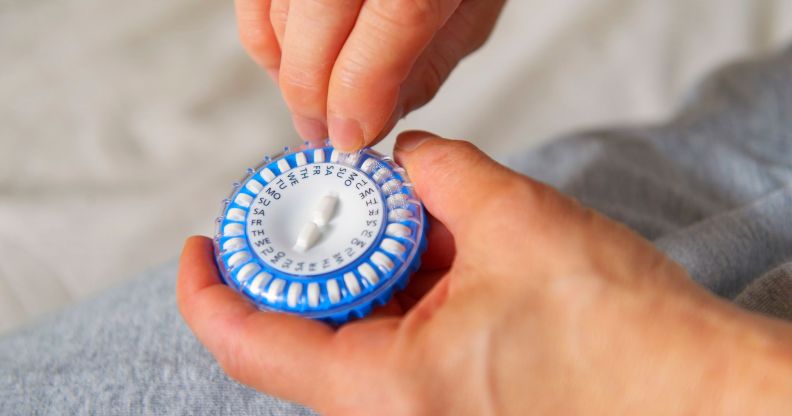What is Hormone Replacement Therapy and how safe is it?

What is HRT, and how safe is it? (Getty Images)
Hormone replacement therapy, or HRT, can be an important part of gender-affirming treatment for many trans and non-binary people.
But what exactly is the medication and how safe is it?
There have been reports that claim there are links between cancer and some trans healthcare, but the truth is that gender-affirming care is considered safe and many cisgender people also take medication prescribed to transgender people, such as puberty blockers and HRT.
Here’s what you need to know about HRT.

What is HRT?
Broadly, HRT can describe several hormone therapies, including oestrogen, progesterone, or testosterone, used by some transgender and non-binary people as part of gender-affirming healthcare.
Feminising HRT is a hormone treatment that can contain oestrogen or progesterone, or both. It’s commonly used to alleviate symptoms of menopause, or as gender-affirming care for transgender women and some non-binary people.
HRT can be come as tablets, or be applied through the skin using patches, gel or spray. This is similar to masculinising testosterone, also known as “T”, which can be given via injections, pills, gel or, again, patches applied to the skin.
When taken as hormone therapy for trans people, feminising HRT is known to increase the size of breast tissue, make body hair lighter and softer, decrease sperm production and testosterone levels, and soften facial features.
Conversely, taking testosterone can stop periods, deepen the voice, increase perspiration and muscle mass, and make body hair appear thicker and darker, among other effects.

How safe is HRT and what are the risks?
There are some risks associated with using HRT, as there are with many medicines – including the birth-control pill. Doctors will explain the potential risks and side-effects before prescribing it.
According to the NHS, the benefits of using feminising HRT usually outweigh the risks for both cis women during menopause and for trans people. Recent evidence shows the risk of serious side-effects are “very low” for all people.
Combined HRT (a drug with oestrogen and progesterone) can slightly increase the chances of breast cancer, but oestrogen-only HRT causes “little to no increase” risk, the NHS says.
HRT may also slightly increase the risk of blood clots if you take it in tablet form, but the NHS reports patches, sprays and gels do not carry this raised risk, because “oestrogen is safer when it’s absorbed into your body through the skin”.
More-common side-effects include headaches, diarrhoea and changes in sex drive. There can be incidental benefits to the drug too, with evidence to show that taking HRT might result in a decreased risk of colorectal cancers.
Testosterone, which many cisgender men also take, can carry a risk of damage to the liver if taken in pill form, with gels and creams causing fewer side-effects. More-common side-effects include weight gain, acne, depression and tiredness.
As testosterone can thicken the blood, there may be an increased risk of heart attacks, strokes and blood clots, so doctors will routinely monitor a patient’s blood pressure while on the drug.
In general, while there are risks associated with many healthcare options, gender-affirming care has not only been proven to be safe, but life-saving in some cases.
In 2023, a report found that gender-affirming care, which can include taking hormones, caused a 50 per cent fall in incidences of depression within the study group, and brought about a 55 per cent reduction in suicidal thoughts.
“HRT is safe and effective when monitored by a healthcare provider,” Paul Carruthers, a nurse consultant from the Gender Plus Hormone Clinic, told PinkNews.
“For some trans and non-binary individuals, it can help alleviate gender dysphoria and assist in aligning physical characteristics with gender identity.
“There may be risks associated with hormone therapy, such as blood clots, changes in cholesterol levels, and potential impacts on fertility, and these should be discussed in depth with the individual’s medical provider.
“No medication is 100 per cent without risks and, like any medical treatment, taking it involves weighing the potential benefits against the risks. It’s crucial for individuals considering hormone treatment to discuss their medical history, risk factors and concerns with a healthcare provider who can give individualised guidance.”
The myths surrounding trans healthcare
Anti-trans campaigners have attempted to stoke panic around transgender healthcare, with gender-affirming care for young people banned in several US states.
In recent years, transgender women were blamed for an HRT shortage in the UK, a theory which was found to be false. In reality, while there has been an increase in referrals to gender identity clinics, there has also been a rise in the number of cisgender women accessing HRT to ease the symptoms of menopause, and this demand has been compounded by wholesale supply shortages.
Data from menopause charities also suggests that awareness around HRT as a treatment for menopause has greatly increased demand for the drug.
Another myth is that transgender people can regret transitioning or undergoing gender-affirming care, which has also been found to be false. A survey of more than 3,000 gender identity clinic applicants in the UK found that 0.47 per cent experienced transition-related regret, and an even smaller number of people actually went on to de-transition.

